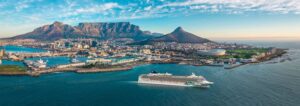Cruise Lines: African Repositioning via Cape Town Not a Viable Alternative to the Suez Canal
In recent years, geopolitical tensions, piracy risks, and logistical congestion have raised concerns over the security and reliability of the Suez Canal—a critical artery for global shipping and cruise operations. While alternative routes have been explored, particularly around the Cape of Good Hope via Cape Town, industry experts agree that for cruise lines, this is not a sustainable or viable substitute for the Suez Canal. The reasons are complex and multifaceted, involving economics, logistics, passenger experience, and strategic alignment with broader maritime trends.
Economic and Operational Constraints
One of the foremost reasons cruise lines are hesitant to adopt the Cape route is cost. Sailing around the Cape of Good Hope adds approximately 3,500 to 4,000 nautical miles to a typical repositioning voyage between Europe and Asia. This translates to an extra 10–14 days at sea, depending on the vessel’s speed. For a cruise line, these additional days mean higher fuel costs, increased crew wages, greater consumption of onboard resources, and reduced fleet utilization. The opportunity cost of keeping a ship at sea without port revenue for nearly two additional weeks can be significant.
Additionally, the Suez Canal—despite its expensive transit fees—is still more cost-effective when compared with the fuel and time costs associated with the Cape route. While container and cargo ships may be forced to take the longer route due to security or political issues, cruise lines, which operate on tighter margins and are customer-focused, have less tolerance for inefficiency.
Limited Port Infrastructure and Support
While Cape Town is a modern, picturesque port, the broader African coastline lacks the comprehensive cruise infrastructure required to support large-scale repositioning. Unlike the Mediterranean or Southeast Asia, which offer a dense network of established cruise terminals, onboard supply logistics, and excursion offerings, the African Atlantic and Indian Ocean coasts are relatively underdeveloped in this regard.

Few ports between Cape Town and Mombasa or even up the West African coast can accommodate the logistical and hospitality demands of major cruise lines. This creates gaps in provisioning, safety inspections, and medical support, all of which are crucial for extended voyages. Moreover, limited shore excursion opportunities in less-developed ports diminish the passenger experience, making such routes less attractive for premium brands that prioritize luxury and engagement.
Passenger Expectations and Market Dynamics
Cruise passengers are typically leisure travelers who prioritize comfort, rich itineraries, and memorable shore experiences. The route around the Cape of Good Hope, while scenic, lacks the density of culturally rich, safe, and varied port destinations that the Suez passage offers. When repositioning, cruise lines often bundle the transfer with a series of destination stops to make the long voyage more marketable.
In contrast, a cruise around the southern tip of Africa includes long sea days and limited call points that may not justify the premium fares cruise lines depend on. Furthermore, insurance costs and safety concerns due to piracy risks off the East African coast—though reduced in recent years—still linger in itinerary planning discussions.
Strategic Fleet Deployment
![]()
The Suez Canal not only offers a time-saving conduit between Europe and Asia but also connects key regional markets: the Mediterranean, Middle East, and Indian subcontinent. For cruise lines managing seasonal deployments, such as summer operations in the Mediterranean and winter programs in Asia or the Middle East, the Suez Canal provides a direct and integrated route.
Avoiding the Suez Canal and rerouting around Africa disrupts this strategic alignment. It displaces schedules, disrupts port partnerships, and complicates logistics that cruise lines plan many months, if not years, in advance. Most cruise lines have complex fleet itineraries tightly aligned with port slot availability, marketing calendars, and local regulations. A longer repositioning voyage would throw off this synchronization.
Environmental Considerations
Cruise lines are under increasing pressure to reduce their carbon footprint and align with global environmental standards. The longer distances and increased fuel consumption involved in the Cape route contradict sustainability goals. Moreover, ports along the African route may not have adequate shore power or emission mitigation infrastructure, increasing the environmental cost of the journey.
Conclusion
While routing via Cape Town may serve as an emergency or occasional alternative to the Suez Canal, it is not a viable long-term strategy for cruise lines. The economic inefficiencies, lack of infrastructure, limited passenger appeal, and disruption to fleet logistics outweigh any perceived benefits. The cruise industry continues to support the stability and security of the Suez Canal as a vital link in global maritime travel and remains focused on optimizing existing, proven routes. Until there is a major shift in African port development or a sustained threat to the Suez, Cape Town will remain a scenic detour—not a strategic alternative.













